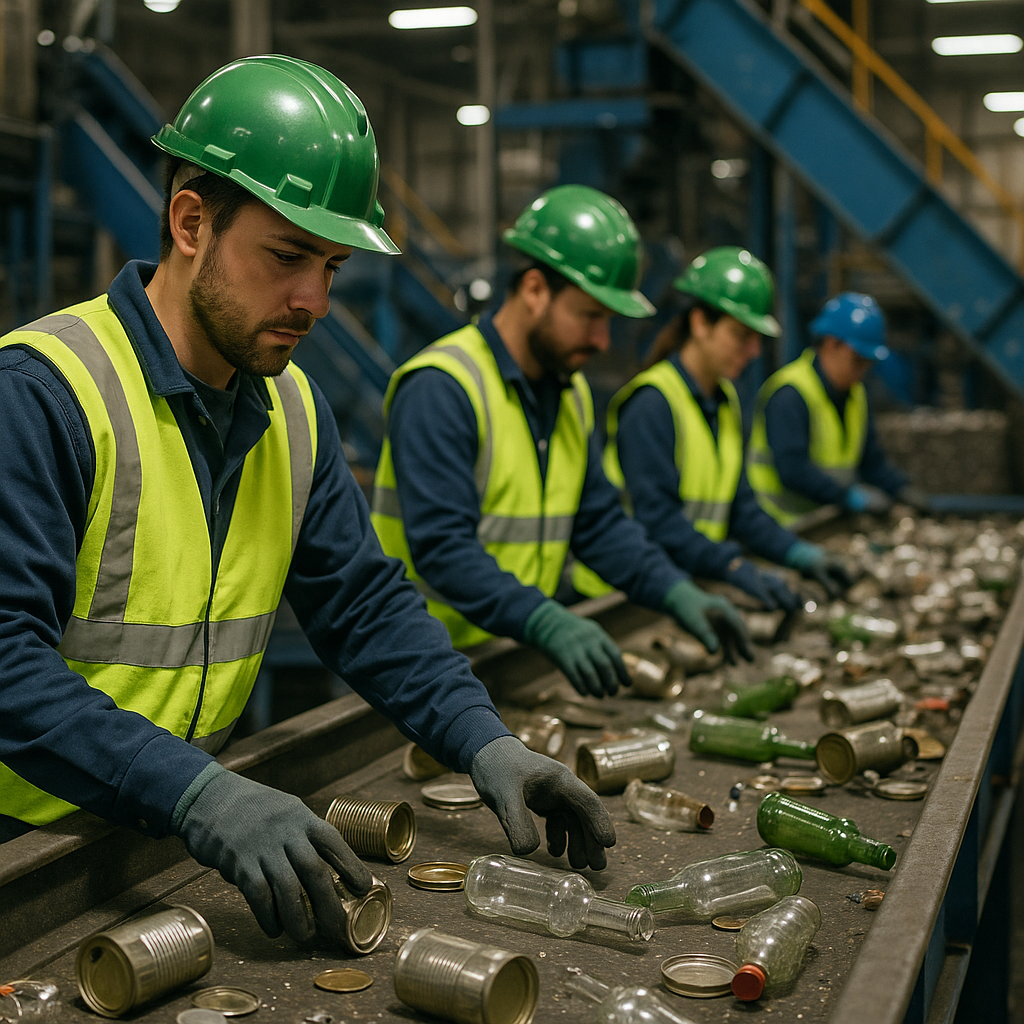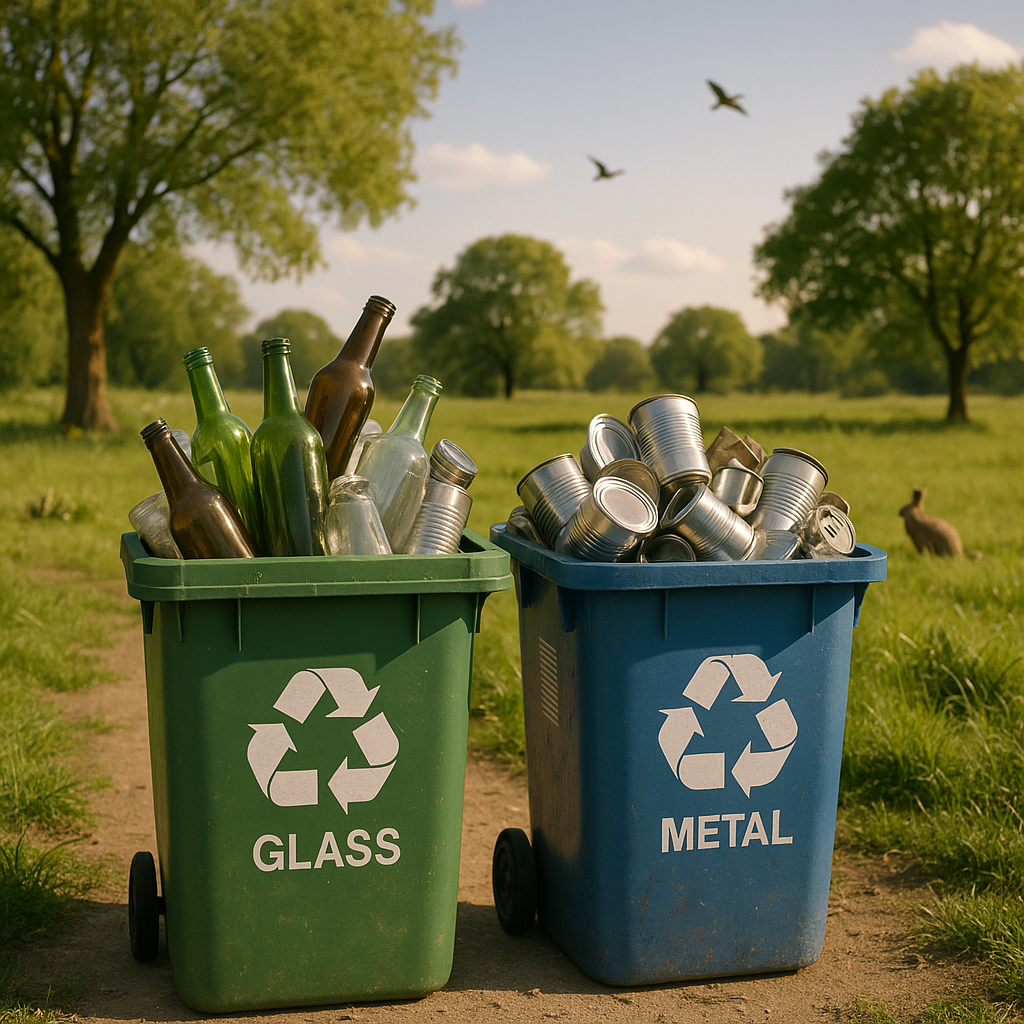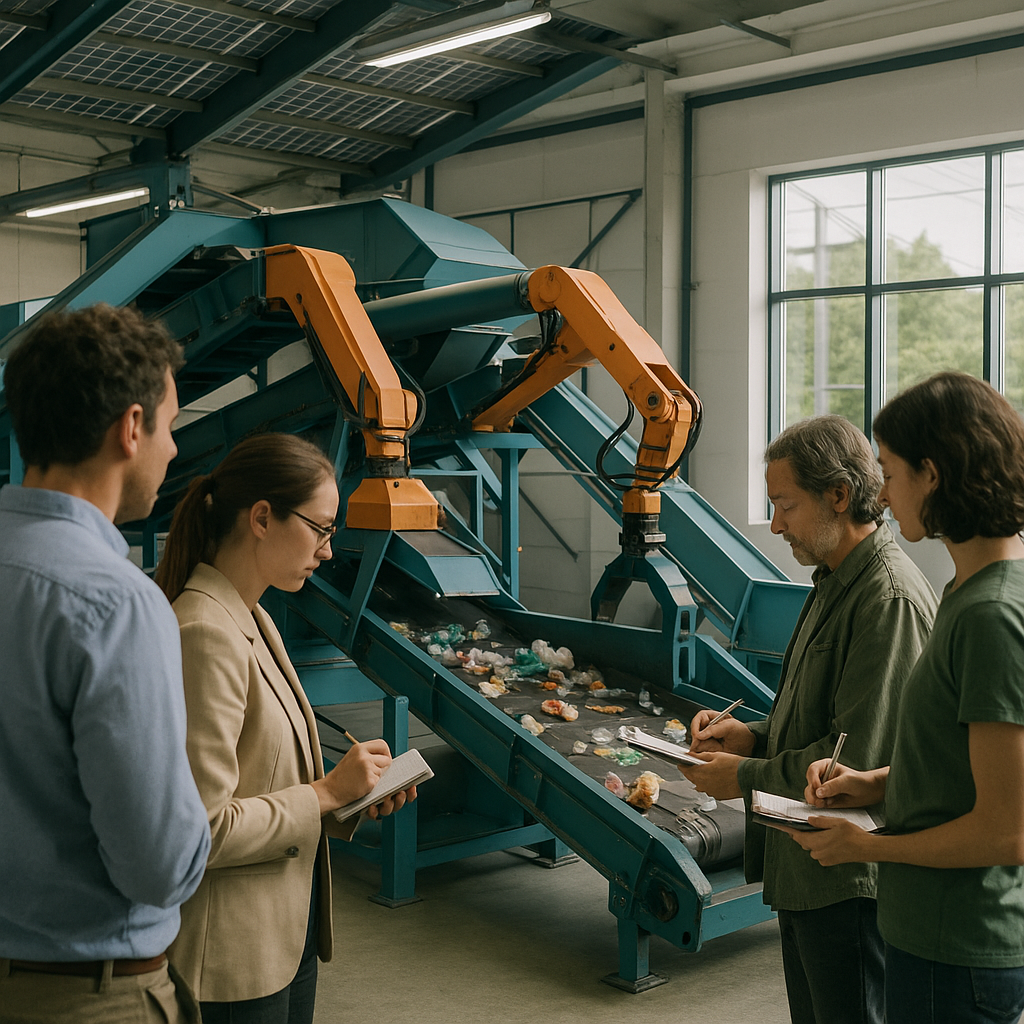5901 Botham Jean Blvd, Dallas, TX 75215
Metal and Glass Recycling: How the Process Works, Benefits, and Challenges
August 28, 2025Metal and glass recycling involves collecting, sorting, and reprocessing used materials into new products. When you toss aluminum cans or glass bottles into your recycling bin, you’re initiating a journey that transforms waste into valuable resources.
Both metal and glass offer unique recycling advantages. Metals like aluminum and steel can be recycled indefinitely without quality degradation. Similarly, glass containers can be melted down and reformed multiple times, maintaining their purity throughout countless cycles. This circular process significantly reduces the need for virgin materials.
The benefits extend beyond conservation. Recycling metal saves up to 95% of the energy required to produce new metal from raw ore, while glass recycling cuts energy use by 30% compared to creating glass from scratch. These energy savings translate directly to reduced greenhouse gas emissions. According to EPA data, recycling programs saved over 193 million metric tons of carbon dioxide equivalent in a single year, making recycling a powerful tool in combating climate change.
How Does the Recycling Process Work?

The recycling process involves several essential stages that transform discarded materials into new products. Each step plays a vital role in reducing waste and conserving natural resources. Understanding how recycling works can help us participate more effectively in this environmentally beneficial system.
Collection
Collection marks the beginning of recycling. Materials are gathered through various methods to ensure they enter the recycling stream rather than ending up in landfills.
Most communities offer curbside pickup services where residents place recyclables in designated bins for regular collection. These programs typically accept common materials like paper, cardboard, certain plastics, aluminum cans, and glass containers. Larger apartment buildings and businesses often have dumpsters specifically for recyclables.
For areas without curbside programs, drop-off recycling centers provide an alternative. These facilities accept a wider range of materials, including items that might not be collected at the curb. Some retailers also offer collection points for specific items like plastic bags or electronics.
Sorting and Processing
Once collected, recyclables are transported to Material Recovery Facilities (MRFs) where the sorting process begins. This critical phase separates different types of materials and removes contaminants.
At the MRF, materials first arrive at the tipping floor, where they’re loaded onto conveyor belts. Pre-sorting removes obvious non-recyclables and potentially harmful items. The remaining materials then go through a series of mechanical and manual sorting processes:
- Paper and cardboard are separated using screens with rotating discs that allow heavier materials to fall through while carrying paper products forward.
- Powerful magnets pull out ferrous metals like steel cans.
- Eddy current separators use magnetic fields to repel non-ferrous metals like aluminum, pushing them into separate collection bins.
- Glass falls through screens and is often sorted by color (clear, green, and amber).
- Optical sorting technology uses infrared sensors to identify different types of plastics.
Material-Specific Processing
After sorting, each material undergoes specialized processing to prepare it for manufacturing into new products.
Metal processing involves shredding the material into small pieces and removing any remaining non-metallic components. The metal is then melted in furnaces at high temperatures. For aluminum, this process uses 95% less energy than producing new aluminum from raw bauxite ore.
Glass processing starts by crushing the material into small fragments called cullet. This cullet is cleaned to remove paper, plastics, and other contaminants. Sorted by color, the cullet is then melted and molded into new glass products. Using cullet reduces the energy needed for glass manufacturing by about 30%.
Paper processing starts with pulping, where the paper is mixed with water to create a slurry. This slurry passes through screens to remove contaminants like staples and plastic. The cleaned pulp is then pressed, dried, and rolled into large sheets for manufacturing new paper products.
Plastic processing varies by type but generally involves washing, shredding, and melting the material. The melted plastic is formed into pellets that serve as raw material for new plastic products.
Manufacturing New Products
In the final stage of the recycling process, processed materials become the raw ingredients for manufacturing new products, closing the recycling loop and demonstrating how discarded items gain new life.
Manufacturers purchase recycled materials based on their specific needs. Recycled aluminum can become new beverage cans, recycled paper transforms into newspapers or packaging, and recycled plastics create everything from clothing fibers to outdoor furniture.
Using recycled materials in manufacturing offers significant environmental benefits. It reduces the demand for virgin raw materials, decreases energy consumption, and lowers greenhouse gas emissions. For example, recycling one ton of paper saves approximately 17 trees and 7,000 gallons of water.
The efficiency of this manufacturing process depends heavily on the quality of the sorted materials. Contamination can disrupt production and decrease the value of recycled materials, highlighting the importance of proper sorting at both the collection and processing stages.
The recycling process is a crucial component of sustainable waste management. By understanding how it works, we can make more informed decisions about our consumption habits and disposal practices, ultimately contributing to a more circular economy that values resources and minimizes waste.
What Are the Environmental Benefits?

Recycling metal and glass significantly benefits our environment through various pathways. Recycling these materials reduces the need for destructive mining and quarrying operations that harm natural landscapes and wildlife habitats. This conservation extends beyond just preserving the physical environment.
The energy savings from recycling are notable. Aluminum recycling is particularly efficient, conserving 95% of the energy needed to produce new aluminum from bauxite ore. This translates into major reductions in carbon emissions and other greenhouse gases contributing to climate change. Steel recycling also cuts CO2 emissions by approximately 58% compared to producing new steel from raw materials.
Glass recycling offers remarkable pollution reduction benefits. The process lowers air pollution by 20% and water pollution by a substantial 50% compared to manufacturing new glass. For every ton of glass recycled, over a ton of natural resources is conserved, including 1,300 pounds of sand, 410 pounds of soda ash, 380 pounds of limestone, and 160 pounds of feldspar.
The cyclical nature of metal and glass recycling provides ongoing environmental benefits. Glass can be endlessly recycled without quality loss, creating a closed-loop system with no additional waste or by-products. Similarly, metals like aluminum and copper retain their properties when recycled, dramatically reducing the environmental impact with each cycle.
Resource conservation also extends to water usage. The mining and processing of raw materials for glass and metal production use vast amounts of water. By recycling these materials, we significantly cut water consumption and prevent the contamination of waterways with mining runoff and industrial pollutants.
The cumulative impact of these benefits is considerable. Industry data indicates that metal recycling saves approximately 500 million tons of CO2 emissions annually — equivalent to removing 110 million cars from roads each year. Through continuous recycling efforts, we foster a more sustainable future with cleaner air, cleaner water, and preserved natural resources.
What Challenges Face Metal and Glass Recycling?

Metal and glass recycling offer significant environmental benefits, but several persistent challenges hinder their full potential. Contamination is one of the most serious obstacles. When recyclable metals and glass contain non-metallic materials, chemicals, or impurities, the quality of the final recycled product declines significantly. This issue is particularly acute in single-stream collection systems, where various recyclables are mixed during collection.
In the metal recycling industry, contamination from plastics, paints, or hazardous substances requires additional processing steps that increase costs and reduce efficiency. For glass recycling, even small amounts of ceramics, stones, or differently colored glass can compromise entire batches. A study by the Glass Recycling Institute found that contamination rates in single-stream collection can reach up to 40%, significantly reducing the value of the collected material.
Economic challenges present another significant hurdle. The costs associated with collection, transportation, and processing sometimes outweigh the financial returns, especially for glass. Glass is heavy and bulky, making its transportation expensive relative to its market value. The infrastructure needed for efficient recycling—including specialized sorting equipment and processing facilities—requires substantial investment that many municipalities struggle to afford.
Market fluctuations further complicate recycling efforts. The prices for recycled metals can vary dramatically based on global economic conditions and demand. For example, aluminum prices fluctuated by over 30% during 2022-2023, creating uncertainty for recyclers. The glass recycling market faces even greater instability due to competition from inexpensive virgin materials. When market prices drop below the cost of processing, recycling programs may become financially unsustainable.
Infrastructure limitations also present challenges in many regions. In some areas, the facilities for efficiently collecting, sorting, and processing recyclable materials are insufficient or outdated, creating bottlenecks in the recycling process and increasing costs. For instance, the United States has recycling rates significantly lower than those in Northern European countries, largely due to infrastructure disparities.
Despite these challenges, innovative solutions continue to emerge. Advanced sorting technologies, more efficient collection methods, and evolving policy frameworks show promise in addressing these obstacles and making metal and glass recycling more viable for the future.
How Can Individuals and Businesses Improve Recycling Efforts?
Improving recycling efforts requires practical action from both individuals and businesses. While many understand recycling’s importance, implementing effective practices can be challenging. Here are some concrete steps that can significantly boost recycling success rates.
Consumer Responsibility: Small Actions, Big Impact
Proper sorting is foundational to effective recycling. Consumers should familiarize themselves with local recycling guidelines, as acceptable materials vary by location. Many municipalities offer detailed sorting guides to clear up confusion about what belongs in each bin.
Preventing contamination greatly enhances recycling efficiency. Rinse food containers before recycling and remove non-recyclable components like plastic windows from paper envelopes. Even small amounts of food residue can contaminate entire batches of recyclables, rendering them unusable.
Setting up dedicated recycling stations at home ensures consistency. Place clearly labeled bins in high-traffic areas such as kitchens and home offices. Use color-coded containers that align with your local collection system for easier identification and sorting.
Business Recycling Programs That Work
Businesses produce substantial waste and have tremendous potential for improving recycling. Conducting a waste audit helps identify the types and volumes of materials your organization produces, enabling tailored recycling solutions for your specific waste stream.
Strategic bin placement dramatically increases participation rates. Position recycling bins alongside trash cans throughout your facility, especially in break rooms, near printers, and in meeting areas. Clear labeling with pictures of acceptable items reduces confusion and contamination.
Employee education transforms recycling culture. Regular training sessions help staff understand what can be recycled and the proper procedures to follow. Creating a dedicated green team can champion these efforts and maintain program momentum through ongoing communication and engagement activities.
Community Infrastructure and Support
Communities play a crucial role in facilitating effective recycling. Investing in modern recycling facilities with advanced sorting technology boosts processing capacity and efficiency, allowing more materials to be recycled with less contamination.
Public education campaigns build awareness and participation. Community workshops, school programs, and clear communication about recycling guidelines help residents understand how and why to recycle properly. Many successful programs use social media and community events to disseminate information.
Supporting container deposit legislation creates powerful incentives. States with bottle bills typically see recycling rates for beverage containers between 70-95%, far exceeding the national average. These programs provide financial motivation for consumers to return containers rather than disposing of them as trash.
Partnering for Success
Working with certified recycling partners ensures materials are truly recycled. Businesses should verify that their waste management providers follow environmentally sound practices and can document where materials end up.
Collaborative initiatives between businesses, government agencies, and community organizations often yield innovative solutions. These partnerships can develop specialized recycling programs for hard-to-recycle items, create educational resources, and advocate for supportive policies.
Setting measurable goals provides direction and accountability. Tracking recycling rates helps individuals and organizations identify what’s working and where adjustments are needed. Regular assessment supports continual improvement.
Conclusion: The Future of Metal and Glass Recycling

Metal and glass recycling is vital for a sustainable future. Effective recycling programs allow these materials to be reprocessed indefinitely without losing quality, dramatically reducing the need for raw resource extraction. The environmental benefits are notable: recycling one ton of glass saves about 600 kg of sand and cuts CO2 emissions by up to 300 kg compared to new glass production.
Challenges remain in collection infrastructure, material contamination, and energy use, but technological advances are rapidly transforming the industry. Artificial intelligence in sorting, improved processing methods, and digital tracking systems are enhancing efficiency and economic viability. These developments, alongside increasing environmental awareness and policy support, are boosting recycling rates in many areas.
For assistance with your recycling needs, contact Okon Recycling at 214-717-4083. Our team of recycling experts can help you implement effective recycling programs for metal and glass materials, ensuring these valuable resources remain in the circular economy rather than ending up in landfills.
